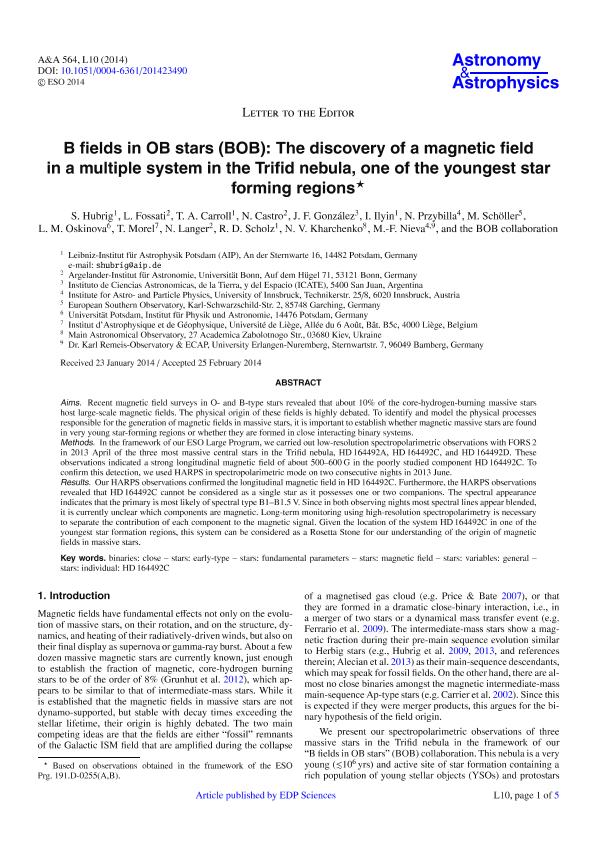Mostrar el registro sencillo del ítem
dc.contributor.author
Hubrig, S.
dc.contributor.author
Fossati, L.
dc.contributor.author
Carroll, T. A.
dc.contributor.author
Castro, N.
dc.contributor.author
Gonzalez, Jorge Federico

dc.contributor.author
Ilyin, I.
dc.contributor.author
Przybilla, N.
dc.contributor.author
Schöller, M.
dc.contributor.author
Oskinova, L. M.
dc.contributor.author
Morel, T.
dc.contributor.author
Langer, N.
dc.contributor.author
Scholz, R. D.
dc.contributor.author
Khachenko, N. V.
dc.contributor.author
Nieva, M. F.
dc.contributor.author
BOB collaboration
dc.date.available
2016-04-01T14:24:07Z
dc.date.issued
2014-04
dc.identifier.citation
Hubrig, S.; Fossati, L.; Carroll, T. A.; Castro, N.; Gonzalez, Jorge Federico; et al.; B fields in OB stars (BOB): The discovery of a magnetic field in a multiple system in the Trifid nebula, one of the youngest star forming regions; EDP Sciences; Astronomy and Astrophysics; 564; L10; 4-2014; 1-5
dc.identifier.issn
0004-6361
dc.identifier.uri
http://hdl.handle.net/11336/4985
dc.description.abstract
Aims. Recent magnetic field surveys in O- and B-type stars revealed that about 10% of the core-hydrogen-burning massive stars host large-scale magnetic fields. The physical origin of these fields is highly debated. To identify and model the physical processes responsible for the generation of magnetic fields in massive stars, it is important to establish whether magnetic massive stars are found in very young star-forming regions or whether they are formed in close interacting binary systems.
Methods. In the framework of our ESO Large Program, we carried out low-resolution spectropolarimetric observations with FORS 2 in 2013 April of the three most massive central stars in the Trifid nebula, HD 164492A, HD 164492C, and HD 164492D. These observations indicated a strong longitudinal magnetic field of about 500–600 G in the poorly studied component HD 164492C. To confirm this detection, we used HARPS in spectropolarimetric mode on two consecutive nights in 2013 June.
Results. Our HARPS observations confirmed the longitudinal magnetic field in HD 164492C. Furthermore, the HARPS observations revealed that HD 164492C cannot be considered as a single star as it possesses one or two companions. The spectral appearance indicates that the primary is most likely of spectral type B1–B1.5 V. Since in both observing nights most spectral lines appear blended, it is currently unclear which components are magnetic. Long-term monitoring using high-resolution spectropolarimetry is necessary to separate the contribution of each component to the magnetic signal. Given the location of the system HD 164492C in one of the youngest star formation regions, this system can be considered as a Rosetta Stone for our understanding of the origin of magnetic fields in massive stars.
dc.format
application/pdf
dc.language.iso
eng
dc.publisher
EDP Sciences

dc.rights
info:eu-repo/semantics/openAccess
dc.rights.uri
https://creativecommons.org/licenses/by-nc-sa/2.5/ar/
dc.subject
Binaries: Close, Stars: Early-Type
dc.subject
Stars: Fundamental Parameters
dc.subject
Stars: Magnetic Field
dc.subject
Stars: Variables: General
dc.subject.classification
Astronomía

dc.subject.classification
Ciencias Físicas

dc.subject.classification
CIENCIAS NATURALES Y EXACTAS

dc.title
B fields in OB stars (BOB): The discovery of a magnetic field in a multiple system in the Trifid nebula, one of the youngest star forming regions
dc.type
info:eu-repo/semantics/article
dc.type
info:ar-repo/semantics/artículo
dc.type
info:eu-repo/semantics/publishedVersion
dc.date.updated
2016-05-06 15:52:43.262787-03
dc.journal.volume
564
dc.journal.number
L10
dc.journal.pagination
1-5
dc.journal.pais
Francia

dc.journal.ciudad
Paris
dc.description.fil
Fil: Hubrig, S.. Leibniz-Institut für Astrophysik Potsdam; Alemania
dc.description.fil
Fil: Fossati, L.. Universität Bonn. Argelander-Institut für Astronomie; Alemania
dc.description.fil
Fil: Carroll, T. A.. Leibniz-Institut für Astrophysik Potsdam; Alemania
dc.description.fil
Fil: Castro, N.. Universität Bonn. Argelander-Institut für Astronomie; Alemania
dc.description.fil
Fil: Gonzalez, Jorge Federico. Consejo Nacional de Investigaciones Cientificas y Tecnicas. Centro Cientifico Tecnologico San Juan. Instituto de Ciencias Astronomicas de la Tierra y del Espacio; Argentina
dc.description.fil
Fil: Ilyin, I.. Leibniz-Institut für Astrophysik Potsdam; Alemania
dc.description.fil
Fil: Przybilla, N.. University of Innsbruck. Institute for Astro- and Particle Physics; Austria
dc.description.fil
Fil: Schöller, M. . European Southern Observatory; Alemania
dc.description.fil
Fil: Oskinova, L. M. . Universität Potsdam. Institut für Physik und Astronomie; Alemania
dc.description.fil
Fil: Morel, T. . Université de Liège. Institut d’Astrophysique et de Géophysique; Bélgica
dc.description.fil
Fil: Langer, N. . Universität Bonn. Argelander-Institut für Astronomie; Alemania
dc.description.fil
Fil: Scholz, R. D. . Leibniz-Institut für Astrophysik Potsdam; Alemania
dc.description.fil
Fil: Khachenko, N. V.. Main Astronomical Observatory; Ucrania
dc.description.fil
Fil: Nieva, M. F.. Institute for Astro- and Particle Physics, University of Innsbruck; Austria. University Erlangen-Nuremberg. Dr. Karl Remeis-Observatory & ECAP; Alemania
dc.description.fil
Fil: BOB collaboration.
dc.journal.title
Astronomy and Astrophysics

dc.relation.alternativeid
info:eu-repo/semantics/altIdentifier/url/http://www.aanda.org/articles/aa/abs/2014/04/aa23490-14/aa23490-14.html
dc.relation.alternativeid
info:eu-repo/semantics/altIdentifier/doi/10.1051/0004-6361/201423490
dc.relation.alternativeid
info:eu-repo/semantics/altIdentifier/doi/http://dx.doi.org/10.1051/0004-6361/201423490
dc.relation.alternativeid
info:eu-repo/semantics/altIdentifier/url/http://arxiv.org/abs/1403.0491
dc.relation.alternativeid
info:eu-repo/semantics/altIdentifier/arxiv/1403.0491
Archivos asociados
